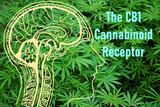Cannabinoid receptor type 1 (CB1, CBR 1) is a receptor protein in the body’s endocannabinoid system. Naturally, this receptor binds with the endocannabinoid anandamide (AEA). However, it is also able to bind to the cannabinoid tetrahydrocannabinol (THC). THC is found in hemp flower in small amounts and marijuana in large amounts.
CB1 was the first cannabinoid receptor to be discovered. It is mainly located in the brain and central nervous system. Cannabinoid receptor type 2 (CB2, CBR2) was discovered later and is found mostly in the peripheral nervous system. For this article, we will help you understand the CB1 cannabinoid receptor.

Table of Contents
What Are Cannabinoid Receptors?
Receptors and their binding compounds are like locks and keys. Cells of the body have an outer “skin” that is covered in receptor proteins. When they encounter molecules (ligands) that partially or totally fit with their structure, they can unlock a cascade of chemical reactions that communicate changes to other cells and other parts of the body. Many signal molecules can be influenced by the endocannabinoid system in this way.
When the body doesn’t produce enough of its own signal molecules, communication is disrupted and throws the body out of balance. This balance is called “homeostasis” and by supplementing the body’s own molecule production with outside sources, balance can be corrected. This is broadly (and very simplified) what is going on when natural anandamide levels are low and THC is taken to provide additional activation of CB1.
CB1 Receptor Benefits
- Encourages neuronal growth, brain plasticity, and cell migration [4]
- Promotes homeostasis
- Reduces pain and inflammation
- A new approach to combating addiction [1]
- Helpful for some mood disorders
CB1 Endocannabinoid Signaling: How Does CB1 Work?
CB1 is a “G-protein-coupled receptor (GPRC)” which means that it uses a type of signaling that involves G proteins. This is a tough scientific process to put in lay terms, but in a nutshell, it is a very common type of signaling used in cellular communication in the body [2, 5]. When molecules bing to GPRCs like CB1, they change shape and that change results in chemical signals being sent out to the body. GPRCs are so common that about 34% of FDA-approved drugs work on them as a therapeutic target. Here is an extremely simplified overview of how this works:
- THC or anandamide (ADA) are consumed
- THC or ADA bind to CB1
- CB1 changes shape and sends signals out to other cells
- Other cells get the signals and change what they are doing
CB1 signal molecules include some major neurotransmitters such as acetylcholine, norepinephrine, dopamine, 5-hydroxytryptamine, glutamate, and GABA. Anxiety, depression, chronic pain, multiple sclerosis (MS), and other neurodegenerative conditions are all significantly impacted by these neurotransmitters [3]. That is why medical marijuana isn’t just something that makes a person feel good, it is actually exerting a pharmacological effect.
CB1 Receptor Effects
You have CB1 receptors in your body from embryo to old age [4]. However, the sensitivity and abundance of CB1 receptors change throughout life. It may surprise you to know that these receptors are very abundant in adolescent brains and both children and the elderly have very different tolerance to THC than teenagers and adults.
When people talk about the benefits of THC, what they are more accurately describing are the benefits of activating CB1. These effects and benefits can impact many parts of the body due to the wide distribution of CB1 receptors.
Most Common CB1 THC Effects
- Getting “high” (intoxication)
- Pain relief
- Altered motor function
- Some types of memory are inhibited
- Down-regulates neurotransmitters by inhibiting common neurotransmitter channels (reason for sedative effects of THC) [3]
THC and Memory
There are CB1 receptors in the brain’s hippocampus and amygdala. When you use THC, these receptors inhibit short-term memory (hippocampus) and also fear memories, pain, and emotional control (amygdala) [3].
Can You Overdose From THC?
It is definitely possible to use too much THC and fell very unwell. However, CB1 receptors are not present in the brainstem like other drug receptors [3]. So where you can die from overdosing on cocaine or heroin, you do not see THC overdose deaths
CB1 Receptor Locations
- The central nervous system (most abundant)
- The peripheral nervous system (less abundant)
- Fat cells (adipocytes)
- The liver
- The pancreas
- Skeletal muscle
- Non-neuron immune cells
Final Thoughts on Cannabinoid Receptor Type 1
CB1 and THC do more together than just get you high. It is important to understand that plant cannabinoids are not so different from natural endocannabinoids in the human body. CB1 plays a big role in regulating and balancing the body and is even key to brain development from childhood through teenage years. That is a big reason why teenagers should not use cannabis products.
However, using THC medicinally as an adult can be a good option for people who have not responded well to traditional treatments. The more you understand the endocannabinoid system, the better you will understand what cannabinoids are really doing in your body and how you can maximize your benefit from them.
References
- De Vries TJ, Schoffelmeer AN (August 2005). Cannabinoid CB1 receptors control conditioned drug seeking. Trends in Pharmacological Sciences. 26 (8): 420–6.
- Gilman AG (1987). G proteins: transducers of receptor-generated signals. Annual Review of Biochemistry. 56 (1): 615–49.
- Kaur, R., R Ambwani, S., & Singh, S. (2016). Endocannabinoid system: a multi-facet therapeutic target. Current clinical pharmacology, 11(2), 110-117.
- Mechoulam, R., & Parker, L. A. (2013). The endocannabinoid system and the brain. Annual review of psychology, 64, 21-47.
- Trzaskowski B, Latek D, Yuan S, Ghoshdastider U, Debinski A, Filipek S (2012). Action of molecular switches in GPCRs—theoretical and experimental studies. Current Medicinal Chemistry. 19 (8): 1090–109. doi:10.2174/092986712799320556.


